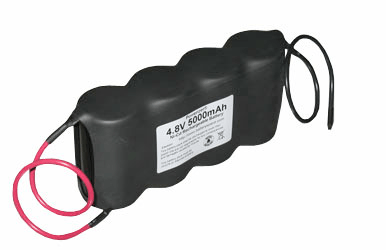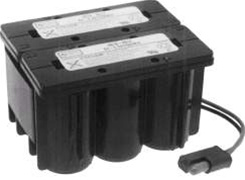Battery Packs and Assemblies Information

Battery packs are constructed from two or more individual cells or batteries. There are two basic types of battery packs: primary and secondary or rechargeable. Primary batteries are disposable, non-rechargeable devices. They must be replaced once their energy supply is depleted. Secondary or rechargeable batteries contain active materials that can be regenerated. When the energy produced by these industrial batteries drops below optimum efficiency, they may be recharged according to various methods, depending on the battery construction. Secondary batteries are useful in applications where frequently replacing disposable batteries is more costly, such as in electric vehicles, handheld power tools and automobile starters.
All batteries have positive and negative terminals, marked (+) and (-) respectively, and two corresponding electrodes. The electrodes must not touch each other, and are separated by the electrolyte, which facilitates the flow of electric charge between the electrodes. A collector conducts the charge to the battery's exterior and through the load.
When a battery is inserted into an electrical device, the device completes the circuit between the two terminals and triggers electrochemical reactions within the battery. The anode undergoes an oxidation reaction with the electrolyte and releases electrons, while the cathode undergoes a reduction reaction and absorbs the free electrons. The product of these two reactions is electricity, which is channeled out of the battery and into the device.
When a secondary battery is recharged, its electrodes undergo an opposite process to the discharging action described above. As the battery charger passes electricity through the battery, one electrode is oxidized and produces electrons which are then absorbed by the other electrode. When the battery is fully charged, it can be connected to a load and discharged again.
Specifications
Voltage
 Battery voltage refers to the electric potential difference between the positive and negative terminal. A battery pack's voltage is the sum of the individual cell voltages. For example, a battery pack containing six 1.5 V cells would be rated at 9 V.
Battery voltage refers to the electric potential difference between the positive and negative terminal. A battery pack's voltage is the sum of the individual cell voltages. For example, a battery pack containing six 1.5 V cells would be rated at 9 V.
Manufacturers typically specify the battery's nominal voltage, although its actual discharge voltage can vary depending on the battery's charge and current. For example, a battery cell with a nominal voltage of 2 V actually discharges between 1.7 and 2.0 volts at a given time. Most round consumer batteries carry a nominal voltage of 1.5 V, while a car battery is typically 12 volts. Depending on the battery materials and application, voltage can range from a fraction of a volt to several kilovolts.
Capacity
The amount of charge a battery can store is known as its capacity. Charge is typically measured in amp-hours or milliamp-hours (Ah or mAh). Most manufacturers specify capacity as the constant current that a new battery can supply for 20 hours. For example, a battery rated at 200 Ah can supply 10 A over a 20 hour period at room temperature. If the current supply to the same battery is increased, the capacity will then decrease.
Packaging
Battery packs are packaged using various methods and materials.
| Taped battery packs are packed together using tape. |  |
Shrink-wrap battery packs use heat shrink tubing to contain the cells. This is the most common packaging available and is typically sufficient for small battery packs. In larger, heavier battery packs, manufacturers may add a sheet of structural material to the top and bottom of the pack. Molded case battery packs are contained in a molded plastic case.
Molded case battery packs are contained in a molded plastic case.
Terminations
A battery's terminations provide an electrical contact between the electrodes and the device or load. Battery packs are manufactured with a variety of termination types.
- Screw terminals are threaded rods and accept an insulated or metal nut.
- Spring terminals are flat metal strips or spiral wound wire.
- Solder terminations require the electrical contacts to be soldered onto a flat metal surface or metal tab.
- Plug-in sockets consist of plugs that mate with an electrical contact's pins.
- Snap fasteners consist of a stud and a socket.
- Wire/cable terminals connect using single or multi-stranded leads, or a cable assembly.
Applications
ef8f59c8847d4d5095745b7b98bcc291.png) Battery packs are manufactured for use in numerous applications.
Battery packs are manufactured for use in numerous applications.
- Consumer batteries are used for general purpose applications, such as cameras, radio-controlled cars, toys, and laptops.
- Energy batteries are manufactured for use in oil, natural gas and solar applications.
- Industrial batteries are deep cycle batteries used in forklifts and other industrial applications.
- Medical batteries are used for life support systems, hearing aids and wheelchairs.
- Military batteries are often manufactured to MIL-SPEC requirements.
- Transportation batteries are designed for use in aircraft, boats, automobiles and electric vehicles.
- Stand-by/UPS batteries are used in uninterruptible power supplies (UPS) for emergency lighting and alarms.
References
PowerStream - How to design battery packs
Image Credits:
People Energy Group | Divine Audio | Tripp Lite | Tenergy Corporation | MonsterMarketplace | Milford Power
- Automotive
- Button Top
- Camera / Electronic Cells
- Disposable (Primary) Batteries
- Electric Vehicle
- General Purpose
- Laptop Batteries
- Marine / Recreational Vehicle
- Medical Equipment
- Military / Aerospace
- Molded Case
- Plug-in Sockets
- Rechargeable (Secondary) Batteries
- Renewable Energy
- Shrink-wrap / Plastic Encapsulation
- Solder
- Stand-by / UPS Batteries
- Telecommunications
- Toy / Hobby
- Wire / Cable
- lithium ion battery pack
- drill battery pack
- NiCd battery pack
- ni mh battery pack
- nickel cadmium battery pack
- 36v battery packs
- emergency battery packs
- li ion battery connector
- 12 volt rechargeable battery pack
- lithium battery storage container
- tmh flexpak battery pack and charger
- 110 volt battery packs
- 12 volt NiCad battery packs
- 12v NiMH battery packs
- 14.4v battery packs
- 18V cordless drill battery packs
- 2 AA battery packs
- 24VDC battery packs
- 3.6V NiMH battery packs
- 3.7v battery packs
- 36v lithium battery packs
- 4.8v battery packs
- 4.8v NiMH battery packs
- 4.8v rechargeable battery packs
- 48V lithium ion battery packs
- 5V 2a battery packs
- 5V lithium ion battery packs
- 6V NiCd battery packs
- 7 2v battery packs
- 7.2 volt battery packs
